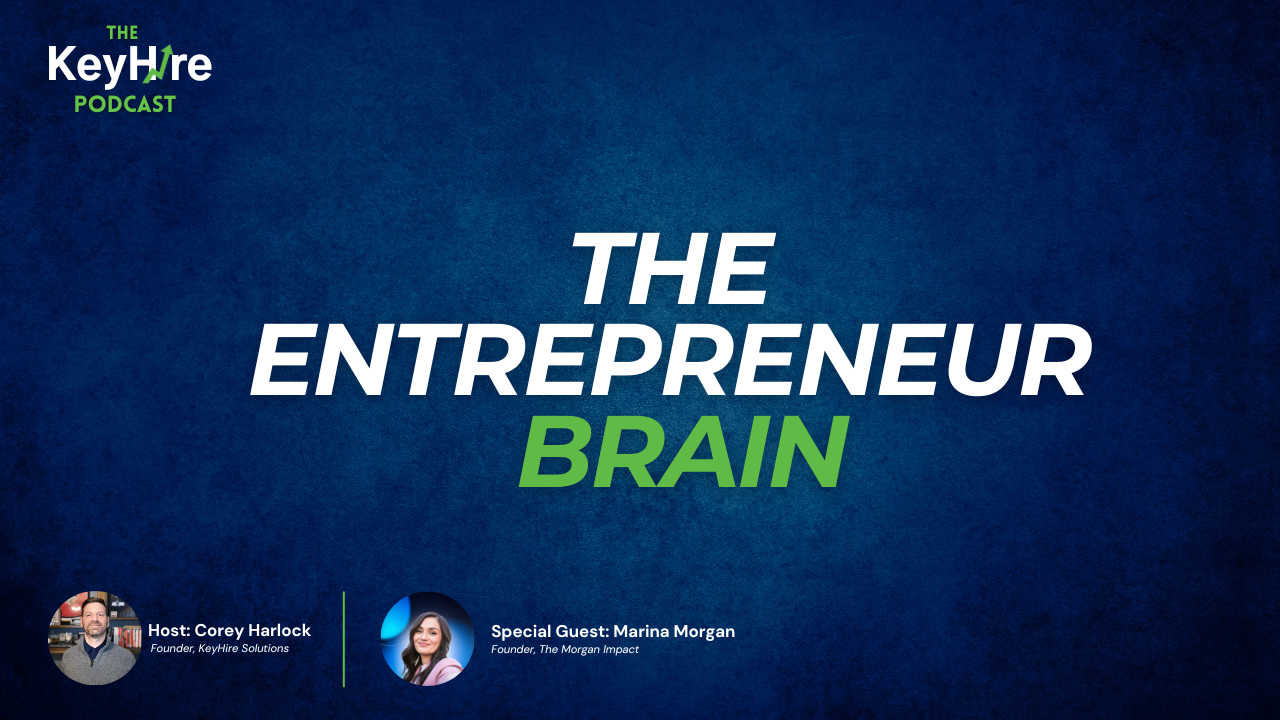Why Small Business Leadership Development Fails When Everyone's "Right" (And How to Fix It)

Imagine this scenario: Your sales director enters the conference room armed with customer feedback and revenue projections. They’re absolutely convinced that maximum flexibility is the key to closing deals and growing the business. Across the table, your operations manager presents equally compelling process documentation and quality metrics. They demonstrate beyond doubt that standardized procedures are essential for sustainable growth. Both leaders are passionate. Both have data. And both are entirely right, from their own perspectives.
This is what Dr. Bob Johnson calls being "100% right in a 200% world." The concept is deceptively simple yet profoundly impactful. In any organizational challenge, each stakeholder can be completely correct from their functional viewpoint. This creates what feels like two separate 100% solutions. The problem isn't that everyone is wrong; it's that the problem's definition itself is too narrow to accommodate everyone's legitimate concerns. As Dr. Bob explains, "until they can remember that they have to grow into a 200% version of that problem, they're going to keep arm wrestling over solutions and escalating problems to bosses."
In a recent KeyHire Solutions podcast episode, host Corey Harlock explored this phenomenon with Dr. Bob Johnson, founder of Team Transformation. Their conversation revealed why even the most capable leadership teams get trapped in these cycles. More importantly, it showed how business owners can transform conflict into a competitive advantage.
The Hidden Cost of "Win and Be Right" Culture
For small businesses generating $5 million to $ 25 million in revenue, each leadership decision carries significant weight. When department heads operate from what Dr. Bob calls a "win and be right mindset," the damage extends far beyond individual disagreements.
This mindset fosters a defensive culture where leaders become more focused on proving they're not the problem than on solving problems. As Dr. Bob explains, "The biggest source of pain in organizations, particularly at more senior levels, is reputational threats. That somehow my function or my team is going to look like we're the ones that drop the ball."
When reputation protection becomes the primary concern, collaboration dies. Department heads come to meetings with their minds already made up, expending energy defending their positions rather than exploring solutions. They listen to respond, not to understand. They concentrate on fixing other teams instead of examining their contributions to the challenge.
The business costs are substantial and often hidden. Leaders escalate problems to you instead of addressing them collaboratively, turning you into a full-time referee when you should be driving growth. Critical decisions get delayed while teams debate who is responsible, rather than focusing on what needs to happen. When decisions are finally made, they lack the full buy-in necessary for successful execution.
Most damaging of all, your organization loses its creative potential. The breakthrough solutions that could serve everyone's needs never emerge because teams remain focused on winning their individual battles rather than solving the bigger challenge together. This leads to the inability to access the collective intelligence that makes great companies exceptional.
Business Growth Tips: Moving from Compromise to Creativity
Traditional leadership advice often focuses on finding the middle ground through compromise. Dr. Bob offers a more powerful alternative: "Our world probably needs more of it, but I'm less interested in compromise and more interested in creativity."
The difference is profound. Compromise typically means everyone gives up something they value. Creativity means expanding the problem definition until you can solve for everyone's core needs simultaneously.
Real-World Example:
- 100% Perspective (Sales): "We need complete flexibility to customize for clients."
- 100% Perspective (Operations): "We need standardized processes to maintain quality."
- 200% Solution: "How do we create flexible systems that maintain quality standards?"
This new perspective creates opportunities that neither party could have imagined independently. The solution might involve modular service components that can be combined freely or at hierarchical service levels, each with distinct quality protocols. The essential approach is to move beyond binary thinking to adopt inclusive solutions.
Leadership Development Through the Three Critical Shifts
KeyHire Solutions collaborates with numerous growing businesses, and we consistently observe three distinct patterns that distinguish high-performing teams from those mired in conflict cycles. Dr. Bob's framework provides a roadmap for transformation:
1. From Closed to Open
The first challenge occurs when teams enter discussions with their minds already made up. Leaders arrive at meetings convinced they have the right answer and spend their time defending their position rather than exploring alternatives. This closed mindset creates defensive conversations where everyone talks but nobody learns.
The transformation happens when you coach leaders to genuinely understand opposing viewpoints until they can articulate them so accurately that the other side says, "Exactly." This isn't about agreeing with every perspective but about demonstrating that you truly comprehend the reasoning behind different approaches. When people feel genuinely heard and understood, trust naturally builds, creating the foundation for productive collaboration.
2. From Static to Dynamic
The second pattern involves teams getting stuck on the problems they know rather than the problems they need to solve. Department heads become so focused on their immediate pain points that they lose sight of the bigger picture. Sales fixates on flexibility, operations on efficiency, and finance on cost control – each viewing the challenge through their functional lens.
The breakthrough comes when you guide leaders to expand problem definitions to include everyone's pain points. Instead of asking "How do we get more flexibility?" the question becomes "How do we create flexibility while maintaining efficiency and controlling costs?" This expanded problem definition naturally leads to solutions that address root causes rather than symptoms, resulting in outcomes that benefit the entire organization.
3. From Problem to Partnership
The final shift addresses how teams view each other during conflicts. Too often, leaders see colleagues from different departments as obstacles to overcome rather than partners in problem-solving. This adversarial mindset turns every disagreement into a zero-sum game where one side must lose for the other to win.
The transformation occurs when leaders recognize that those who complain most often care most deeply about the business. That passionate operations manager isn't trying to block sales – they're protecting quality standards because they care about customer satisfaction. When you help leaders reframe their perspective this way, conflict becomes a catalyst for innovation rather than a source of dysfunction.
Avoiding Common Leadership Mistakes When Scaling a Small Business and When Everyone's "Right"
Even well-intentioned business owners fall into predictable traps when their teams clash. Here are the most costly mistakes we see – and how to avoid them:
- The Referee Leader: Stepping in to make decisions when teams can't agree feels efficient, but it creates dependency and undermines team development. Your $ 200 K+ leaders should be solving these problems, not escalating them.
- The Hands-Off Approach: Hoping conflicts will resolve themselves rarely works. Problems typically go underground or resurface with greater intensity.
- The Relationship Band-Aid: Suggesting team members "just get lunch together" addresses symptoms, not systems. Surface-level relationship building doesn't solve structural alignment issues.
- The Premature Solution: As Dr. Bob notes, we often "believe solutions are more valuable than problems" and rush to fix things before fully understanding what needs fixing. This approach virtually guarantees problems with buy-in later.
- The Single Perspective Trap: When you consistently favor one department's viewpoint (often sales, given revenue pressures), you may win short-term battles while losing long-term organizational capability.
Taking Action: Your Next Steps
Ready to transform your leadership team dynamics? The journey begins with an honest assessment of your current situation. Start by identifying your organization's most persistent "here we go again" conflicts – those recurring disputes that seem to resurface every few months, regardless of how many times you think they've been resolved. Take note of the stakeholders involved and their typical positions, but more importantly, recognize your own patterns. Which side do you typically favor and why? Understanding your unconscious biases is crucial because your team will mirror your approach to conflict resolution.
Once you've mapped the landscape, begin practicing the "exactly" test with your next team conflict. Rather than jumping into a referee role, coach one leader to articulate their opponent's viewpoint until the other party acknowledges it as accurate. This single practice will feel awkward at first, but it's transformative. You're essentially teaching your leaders to expand their problem definitions to include multiple perspectives, which is where breakthrough solutions emerge.
As these skills develop, implement new meeting protocols that require problem exploration before solution generation. Train your leadership team on the three critical shifts framework, emphasizing that problems are more valuable than solutions because all the creativity and partnership potential lies in properly understanding what you're trying to solve. Create accountability measures for collaborative problem-solving, making it clear that bringing solutions rather than problems to your office is now the expectation.
A lasting culture change occurs when you regularly acknowledge instances of creative solutions rather than opting for either/or compromises. Share stories of successful cross-functional collaboration in team meetings and company communications. Most importantly, make problem-solving partnership a key leadership competency in performance reviews and hiring decisions. When your team sees that collaborative problem-solving is valued and rewarded, the behavior becomes self-reinforcing throughout your organization.
Key Takeaways
Dr. Bob's insights reveal a fundamental truth: "The problem isn't the problem. The problem is how we deal with the problem." For small business owners serious about sustainable growth, this distinction is game-changing.
- Embrace the 200% Mindset: When conflicts arise, expand your problem definition rather than picking sides
- Develop Internal Capacity: Your leadership team should be solving problems, not escalating them to you
- Focus on Partnership: The energy behind complaints often reflects deep caring – channel it toward solutions
The businesses that thrive in today's complex marketplace aren't those with the smartest individual contributors – they're the ones that harness collective intelligence most effectively. When your leadership team masters the art of collaborative problem-solving, you're not just resolving today's conflicts; you're building tomorrow's competitive advantage.
Ready to stop refereeing and start leading? KeyHire Solutions specializes in helping growing businesses develop and hire the leadership talent that drives sustainable success. Because in a 200% world, the companies that win are those that refuse to settle for 100% solutions.
Want to dive deeper into these concepts? Listen to the full conversation with Dr. Bob Johnson on the KeyHire Small Business Podcast.
Learn more about Dr. Bob: https://teamtransformationmethod.com/ and https://www.linkedin.com/in/drbobjohnson/
Check out our sponsor:
Career Spring, Careers launch here: https://careerspring.org/
Connect With Us:
KeyHire Solutions, Be Our Next Success Story: https://www.keyhire.solutions/testimonials
Contact Corey: corey@keyhire.solutions











